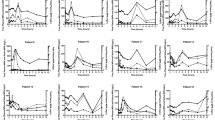Summary
In an open-label, randomized, crossover study 12 healthy volunteers were given clarithromycin orally 250 mg twice daily (b.i.d.) and 500 mg once a day (q.d.). Blood and saliva samples were collected on study days 1 and 5 to determine the pharmacokinetics of clarithromycin and its 14-hydroxy metabolite in plasma and saliva, and to measure concentrations of clarithromycin in mononuclear cells (MNCs) and polymorphonuclear leucocytes (PMNs). The mean peak levels of clarithromycin on day 5 of therapy in serum (2.3 vs. 1.2 mg/l), saliva (1.1 vs. 0.3 mg/l) and blood cells 60 vs. 26 mg/l in MNCs and 29 vs. 14 mg/l in PMNs) were at least doubled, the trough levels were lower with 500 mg q.d. vs. 250 mg b.i.d. (0.09 vs. 0.28 mg/l in serum; 0.06 vs. 0.13 mg/l in saliva; <1 vs. 6.8 mg/l in MNCs; 0.8 vs. 2.8 mg/l in PMNs). The mean relative peak serum concentrations of the 14-hydroxy metabolite were somewhat lower with the 500 mg dosage (0.78 vs. 0.46 mg/l). The peak concentrations of clarithromycin and its 14-hydroxy metabolite in saliva were 25–40% and 50–80% of the maximum serum concentrations with both dosage regimens. Clarithromycin exhibits good and rapid penetration into intracellular as well as into extravasal extracellular body compartments. Clarithromycin 500 mg q.d. compares favourably with 250 mg b.i.d., as far as peak serum levels and bioavailability are concerned, but trough levels are lower at the end of the 24-hour dosing interval.
Zusammenfassung
Zwölf gesunde freiwillige Probanden erhielten in einer offenen, randomisierten Cross-Over-Studie zweimal 250 mg Clarithromycin täglich und einmal 500 mg täglich. Am ersten und fünften Tag der Therapie wurden die pharmakokinetischen Parameter von Clarithromycin und seinem aktiven Metaboliten, 14-Hydroxy-Clarithromycin, in Serum, Speichel und Blutzellen (polymorphkernige Leukozyten (PMNs) und mononukleären Zellen (MNCs; nur Clarithromycin) bestimmt. Die mittleren Maximalkonzentrationen von Clarithromycin an Tag fünf waren nach 500 mg Clarithromycin einmal täglich mindestens doppelt so hoch wie nach 250 mg zweimal täglich (Serum: 2,3 vs. 1,2 mg/l; Speichel: 1,1 vs. 0,3 mg/l; MNCs 60 vs. 26 mg/l; PMNs 29 vs. 14 mg/l), die Talspiegel hingegen waren deutlich niedriger (Serum: 0,09 vs. 0,28 mg/l; Speichel: 0,06 vs. 0,13 mg/l; MNCs: <1 vs. 6,8 mg/l; PMNs: 0,8 vs. 2,8 mg/l). Die mittleren, relativen Serumkonzentrationen des aktiven Metaboliten, 14-Hydroxy-Clarithromycin, waren hingegen niedriger nach 500 mg Clarithromycin vs. 250 mg (0,78 vs. 0,46 mg/l). Die mittleren Maximalkonzentrationen in Speichel betrugen bei Clarithromycin 25–40% und bei Hydroxy-Clarithromycin 50–80% der maximalen Serumkonzentrationen. Clarithromycin zeigt eine gute und schnelle Diffusion in intrazelluläre und extrazelluläre Körperkompartimente. Im Hinblick auf Bioverfügbarkeit und Maximalkonzentrationen kann das Therapieschema von 500 mg einmal täglich gut mit dem Schema zweimal 250 mg täglich konkurrieren, die Talspiegel am Ende des 24-Stunden-Dosierungsintervalls sind jedoch niedriger.
Similar content being viewed by others
References
Ferrero, J. L., Bopp, B. A., Marsch, K. C., Quigley, S. C., Johnson, M. J., Anderson, D. J., Lamm, J. E., Tolman, K. G., Sanders, S. W., Cavanaugh, J. H., Sonders, R. C. Metabolism and disposition of clarithromycin in man. Drug Metab. Disposition 18 (1990) 441–446.
Neu, H. C. The development of macrolides: clarithromycin in perspective. J. Antimicrob. Chemother. 27 (Suppl. A) (1991) 1–9.
Peters, D. H., Dissold, S. P. Clarithromycin — Eine Übersicht der antimikrobiellen Aktivität, der pharmakokinetischen Eigenschaften und des therapeutischen Potentials. Drugs 44(1) (1992) 117–164.
Anderson, R., Joone, G., van Rensburg, C. E. J. Anin vitro evaluation of the cellular uptake and intraphagocytic bioactivity of clarithromycin (A-56268, TE-031), a new macrolide antimicrobial agent. J. Antimicrob. Chemother. 22 (1988) 923–933.
Ishiguro, M., Koga, H., Kohno, S., Hayashi, T., Yamaguchi, K., Hirota, M. Penetration of macrolides into human polymorphonuclear leucocytes. J. Antimicrob. Chemother. 24 (1989) 719–729.
Kohno, S., Koga, H., Yamaguchi, K., Masaki, M., Inoue, Y., Dotsu, Y., Masuyama, Y., Hayashi, T., Hirota, M., Saito, A. A new macrolide, TE-031 (A-56268), in treatment of experimental Legionnaires' disease. J. Antimicrob. Chemother. 24 (1989) 397–405.
Loos, U., Kees, F. Bronchopulmonale Pharmakokinetik von Clarithromycin. Atemwegs-und Lungenkrankheiten 17 (1991) 423–424.
Kohno, Y., Yoshida, H., Suwa, T., Suga, T. Uptake of clarithromycin by rat lung cells. J. Antimicrob. Chemother. 26 (1990) 503–513.
Chu, S.-Y., Sennello, L. T., Bunnell, S. T., Varga, L. L., Wilson, D. S., Sonders, R. C. Pharmacokinetics of clarithromycin, a new macrolide, after single ascending oral doses. Antimicrob. Agents Chemother. 36 (11) (1992) 2447–2453.
Andro, R., Lode, H., Schiller, C., Fassbender, M., Rau, M., Borner, K., Koeppe, P.: Comparative pharmacokinetics and tissue concentrations of macrolide antibiotics. 32nd ICAAC, Anaheim, USA, Oct. 11–14 (1992) Abstr. 181.
Tulkens, P. M. Intracellular distribution and activity of antibiotics. Eur. J. Clin. Microbiol. Infect. Dis. 10 (1991) 100–106.
Labro, M.-T. Intraphagocytic penetration of macrolide antibiotics. In:Bryskier, A. J., Butzler, J.-P., Neu, H. C., Tulkens, P. M. (eds.): Macrolides: chemistry, pharmacology and clinical uses. Arnette Blackwell, Paris 1993, pp. 379–388.
Wise, R., Andrews, J. M., Honeybourne, D., Kees, F.: The penetration of azalides and macrolides into the respiratory tract. 2nd Internatl. Conf. Macrolides, Azalides and Streptogramins, Abstr. 193, Venice, Jan. 19–22 (1994).
Acar, J. F., Saint-Salvi, B., Blanc, F. Concentrations of roxithromycin in tear fluid and saliva after repeat dosing. Br. J. Clin. Practice 42 (Suppl. 55) (1988) 82.
Nilsen, O. G. Roxithromycin. A new molecule, a new pharmacokinetic profile. Drug Investigation 3 (Suppl. 3) (1991) 28–32.
Sedlmayr, T., Peters, F., Raasch, W., Kees, F. Clarithromycin, ein neues Makrolid-Antibiotikum. Wirksamkeit bei puerperalen Infektionen und Übertritt in die Muttermilch. Geburtshilfe und Frauenheilkunde 53 (1993) 489–491.
Craig, W. A. Post-antibiotic effect of macrolides. In:Bryskier, A. J., Butzler, J.-P., Neu, H. C., Tulkens, P. M. (eds.): Macrolides: chemistry, pharmacology and clinical uses. Arnette Blackwell, Paris 1993, pp. 205–208.
Author information
Authors and Affiliations
Rights and permissions
About this article
Cite this article
Kees, F., Wellenhofer, M. & Grobecker, H. Serum and cellular pharmacokinetics of clarithromycin 500 mg q.d. and 250 mg b.i.d. in volunteers. Infection 23, 168–172 (1995). https://doi.org/10.1007/BF01793859
Received:
Accepted:
Issue Date:
DOI: https://doi.org/10.1007/BF01793859




